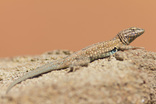This week found Celina & Devin surveying in eastern Colorado before heading south to sample in Texas and New Mexico. Beth & Jake left earlier for surveys in Texas before meeting up late in the week with Danny in south-central Oklahoma.
| Celina - "August means clutches of babies are out and about, and it's so exciting! It confused my search image on Monday when I lifted a dry cow patty to see two black and dark blue squiggles wiggle off in opposite directions. I was stunned at first- what in the world?! - and then I realized: hatchling Many-lined Skinks! My moment of stunned confusion cost me the voucher photos I could have gotten, unfortunately, but now I'm more carefully looking for baby reptiles." Jake - See the post for Week 17 for Jake's assessment of Weeks 16-17 spent in Oklahoma & Texas! | Devin - "The first sightings of hatchlings & neonates this season have finally occurred! We've started to see juvenile Lesser Earless Lizards no larger than a thumbnail. On one occasion this week I happened upon a juvenile Plains Garter Snake crawling through some short grass as well. I didn't realize how difficult some of these tiny reptiles were going to be to spot, and I had to walk a little more slowly so I could improve my chances of detecting them! I was also a little thrown off because some juvenile lizards don’t look the same as their adult form, such as some of the juvenile Great Plains Skinks we found this week, with their sleek black bodies fading to a bright blue tail." |
Beth - "After not seeing as many reptiles out in the field for the past few weeks, it was a pleasant surprise to see four snakes on one road in about 20 minutes. Even better, one of those was a Plains Hog-nosed Snake. This Plains Hog-nosed Snake was the first live specimen I've seen. It curled into its notorious defensive posture, tucking it's head beneath its coils and piling it's tail atop its body like a deceitful hat."
 RSS Feed
RSS Feed
